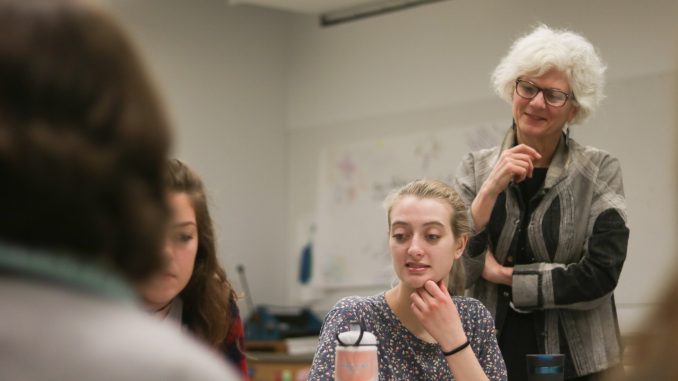
Lisa Kay and a young brain-tumor patient twirled their fingers in the air to color an imaginary canvas. It was the only art they could still create as the boy’s dexterity diminished.
She still recalls her work with the boy at Mercy Hospital St. Louis as a defining moment of her 35 years in the field.
“I learned a lot from him,” said Kay, the head of Temple’s art education program. “Art helped stabilize and create some sort of normalcy in his life when he knew he was dying.”
Nearly 30 years later, the arts education and community arts practices department within the Tyler School of Art is planning to offer an art therapy major starting in Fall 2017. According to the American Association of Art Therapy, art therapy is a mental health profession that uses the creative process as a way to heal and promote mental health.
Before working as an art therapist, Kay worked as a graphic designer.
“I realized something was missing from my life,” she said. “I wanted to work with people.”
Kay wasn’t sure how she could combine her love of art and working with people until she came across a book called “The Psychology of Children’s Art.” She was fascinated by the parallels across cultures when it came to children’s visual development. From there, she started to volunteer at a children’s hospital.
The same ideology — that art can help enhance life for those in pain — is what she hopes the program can teach students in the school.

Although students must receive a master’s degree in order to practice as an art therapist, Kay said the program will help prepare students who are interested in a graduate program.
For students who choose not to pursue graduate school, the program could still lead to several career choices, with opportunities in nursing homes, community art centers and rehabilitation facilities.
Tamryn McDermott, the director of admissions at Tyler and a 2005 master’s of art history alumna, saw interest in an art therapy program while she visited local high schools to meet with prospective students.
“We suggested students to apply for the visual studies major and psychology,” McDermott said. “But … so many students had an incredible interest in pursuing art therapy, so adding this just naturally fell into place.”
Incoming freshmen have already been accepted into the program and paid their deposits, McDermott said. To apply, students must submit an art portfolio that shows potential to develop the skills necessary for art therapy.
Requirements for the major include classes in studio art, psychology, art history and art therapy. The art therapy classes will include guest speakers, self-expressive art and fieldwork.
Students who are interested in transferring into the major can speak with advising in the spring about applying for the fall semester, McDermott said.
Art therapists are trained to interpret certain signs in a client’s artwork that can be an indicator of certain mental health issues.
As undergraduate art therapy students, however, they will not learn how to make mental health assessments on clients by interpreting their artwork.
“They will be exposed to it, but they will not learn it here,” Kay said. “It’s not in their realm of practice.”
Students will instead be exposed to a strong foundation in art courses and an opportunity to shadow an art therapist as part of their capstone course.
The school currently offers Introduction to Art Therapy, which is taught by Kay. The class includes group art-making exercises, said Caroline Kline, a non-matriculated student enrolled in the class.
The class created a combined mural project which featured artwork from each student. Kline said projects like this helped tie together required readings.
“We learned how a combined mural could be a way for art therapists to assess how a person may be relating to other people,” Kline said.
On Tuesday, Denise Wolf, an instructor in Drexel University’s Graduate Art Therapy and Counseling program, will be speaking in Room B086 in Tyler. Her lecture, “Answered: Burning Questions About a Career in Art Therapy,” will run from 1:45 to 2:45 p.m.
Kay said art therapy can be difficult to study and practice, but ultimately it is rewarding.
“You need to be out there doing some work to see if you really do like this,” she said. “This is not easy. It’s painful to see people in pain.”
Kait Moore can be reached at kaitlyn.moore@temple.edu.


Be the first to comment